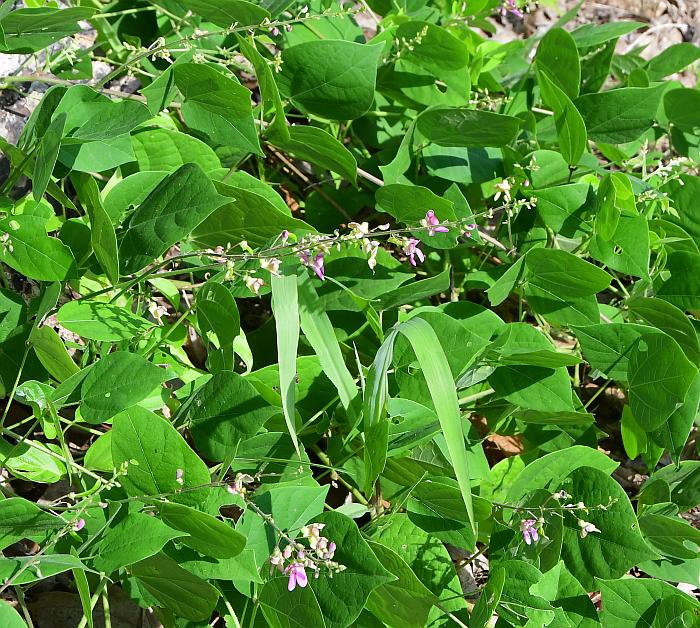Phaseolus polystachios (L.) Britton, Sterns & Poggenb.
Wild Bean

Native
CC = 7
CW = 5
MOC = 34
© SRTurner
Phaseolus polystachios (L.) Britton, Sterns & Poggenb.Wild Bean | |
 |
Native CC = 7 CW = 5 MOC = 34 |
© SRTurner |
|
Family - Fabaceae/Faboideae Habit - Perennial forb from a stout, branched, tuberous rootstock. Stems - Twining, climbing, or occasionally trailing, to 4 m, sometimes multiple from the base, often purplish-tinged, usually moderately to densely pubescent with short, spreading hooked hairs, sometimes also with scattered, longer, spreading to downward-angled, straight hairs.
Leaves - Alternate, stipulate, pinnately trifoliate, petiolate. Petioles 3-8 cm long, moderately to densely hairy, the terminal leaflet stalk 7-35 mm long. Stipules 1.5-3.0 mm long, oblong-triangular to narrowly oblong-ovate, herbaceous, persistent, strongly parallel-veined. Stipels 0.8-2.5 mm long, persistent. Leaflets 3-8 cm long, 2-7 cm wide, ovate to broadly ovate, the lateral ones usually asymmetrically so, the terminal leaflet sometimes somewhat rhombic, broadly rounded or broadly angled (obliquely so in lateral leaflets) at the base, tapered to a sharply pointed tip, unlobed, the upper surface sparsely to moderately short-hairy along the main veins, sometimes nearly glabrous, the undersurface sparsely to moderately short-hairy, mostly along the veins.
Inflorescence - Well-developed axillary racemes, often branched at the base (thus appearing paniculate), extending beyond the subtending leaves, 5-20 cm long, with 10 to numerous flowers, the flower stalks 4-8 mm long. flower stalks with small bracts at the base, these 0.7-1.2 mm long, oblong to oblong-lanceolate or narrowly oblong-ovate, often with strong parallel venation, persistent; each flower also closely subtended by 2 small bractlets, these 0.7-4.0 mm long, oblong to lanceolate or broadly ovate, persistent.
Flowers - Calyces sparsely to moderately and finely short-hairy on the outer surface, densely short-hairy on the inner surface and margins, the tube 1.6-2.2 mm long, the upper lip 0.3-0.8 mm long, the lobes rounded to broadly and bluntly pointed at the tips, the lowermost lobe 0.8-1.2 mm long, triangular. Corollas papilionaceous, pink to light purple, the petals usually pale toward the base, the banner sometimes greenish-tinged on the outer surface, generally appearing somewhat hooded over other petals, 6-9 mm long, 8-11 mm wide, the wings 10-13 mm long, 4-7 mm wide, oblong, usually longer than the banner and keel, the keel usually greenish yellow to greenish white toward the tip, tightly coiled. Stamens 10, 9 of the filaments fused to above the midpoint and 1 filament more or less free, the anthers small, attached near the base, all similar in size. Ovary sessile or nearly so, with a small nectary disc encircling the base, this sometimes somewhat lobed, the style coiled, 8 mm long, often jointed toward the base, bearded on the upper side, the stigma more or less lateral or oblique, elongate.
Fruits - Legumes 3-6 cm long, 7-10 mm wide, flattened, linear to narrowly oblong, usually slightly curved, with a short stalk to 3 mm long, short-beaked at the tip, the valves relatively thin, tan, glabrous, 4-6-seeded. Seeds 6-10 mm long, 5-8 mm wide, oblong to broadly kidney-shaped in outline, dark reddish brown mottled with black or solid black.
Flowering - July - September. Habitat - Streambanks, bases and ledges of bluffs, forest openings, roadsides. Origin - Native to the U.S. Lookalikes - Various species of Lathyrus, Strophostyles, and Desmodium. Other info. - This attractive species can be found in the lower half of Missouri, and scattered throughout the southeastern quadrant of the continental U.S. The plant is recognized by its vining habit, large trifoliate leaves which cling to clothing, and narrow racemes of pink flowers. The seeds are beans and are closely related to the common culinary beans (P. vulgaris). Note that many beans are mildly toxic when raw and should not be consumed in quantity. Cooking destroys the toxins. Photographs taken in the Talladega National Forest, AL., 9-11-05 (DETenaglia); also at Salt Lick Point, near Valmeyer, Monroe County, IL, 7-15-2022 and 7-28-2022 (SRTurner). |